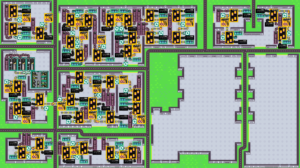Factory Idle and Reactor Idle
Reading some discussion of Factory Idle online led me to Reactor Idle, an earlier work by the same artist, themed around building power plants. Reactor Idle doesn’t have conveyor belts — its simulation is more about heat transfer and making sure your buildings don’t catch fire. But other than that, the games are strikingly similar in a lot of ways, starting with the look and feel of the UI.
Both games are based around a system of two goal resources, money and research. Money buys buildings and globally upgrades them, while research unlocks new kinds of buildings and upgrades. You need them both, because research gets you to the next tier of money-making and money gets you the buildings that do the research, but there’s no obvious answer to the question of how much you should be spending on upgrading each. Also, both games have a thing going on where very large quantities of money will buy access to new areas, called “plants” in Reactor Idle and “factories” in Factory Idle. It seems at first like these areas might be levels, different disjoint spaces that you complete by getting enough money and proceeding to the next, but it’s more interesting than that. Your money and research pools are independent of which area you’re in, and all areas keep on producing money and research when you leave them. So it’s more like these areas are all just further expansions of a single industrial empire, except for one unexpected twist: Although your research carries over to all areas, your upgrades do not. Each area must be upgraded independently. This is enough of an oddity that I’d suspect a connection between two games that did it even if the connection weren’t already so obvious.
This special rule suggests that different areas can be upgraded differently to pursue different specializations. And indeed, I’ve pursued that quite extensively in Reactor Idle, where I’ve given over the initial island entirely to research, filling every buildable tile with research buildings and upgrading nothing else there. This is a viable approach in that game because research buildings consume nothing but the land they sit on. Factory Idle makes things more complicated. Research buildings there require money to run, and conveyor-belt feeds of factory-produced items to run optimally. Thus, a certain amount of factory production upgrading seems wise even in a research colony. But I’m still doing specialization on other channels: I didn’t bother upgrading steel production at all in my second factory, having already researched the much more lucrative plastics.
Discovering two games of this sort in a short period of time has had one strange effect. As I’ve noted, idling games are best played in the background, as something you can check on periodically while doing something else. And while these two games have a greater than usual amount of non-idling time, they do eventually develop stretches where you’re just waiting for your money or research to reach some threshold. But by playing both of them simultaneously, I can be actively playing one game while waiting on the other. In effect, it eliminates downtime by having multiple channels for action, even though there’s downtime on each of them. It strikes me that this is something that could be exploited even within a single game.
 Comments(0)
Comments(0)